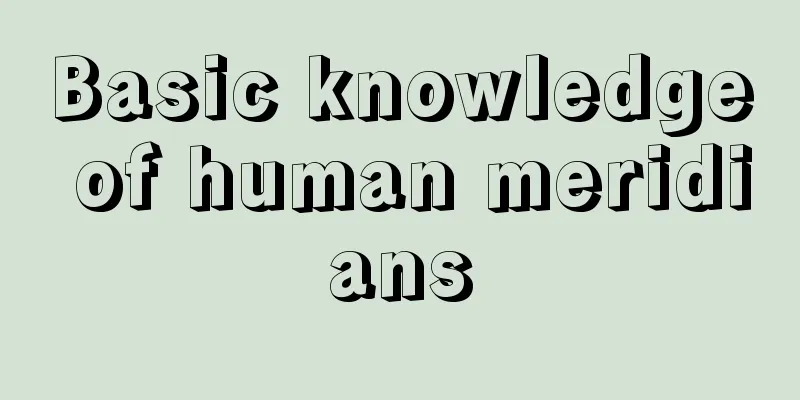Basic knowledge of human meridians

|
The main function of the human body's meridians is to ensure the smooth flow of qi and blood. If the meridians are blocked, the discharge of blood and toxins in the body will also be blocked, and naturally the health of the body cannot be guaranteed. Therefore, everything in the human body comes from the normal operation of the meridians. Meridians are divided into two types: regular meridians and extraordinary meridians. Regular meridians are the main meridian channels, and extraordinary meridians are auxiliary small meridians. The following is a brief introduction to the meridians of the human body: It all starts with the meridians: Meridian is a term unique to Traditional Chinese Medicine. The meridian theory is one of the core basic theories of Traditional Chinese Medicine and the basis of acupuncture and massage of the human body. Simply put, meridians are channels through which qi and blood flow, connecting internal organs, the body surface, and all parts of the body. They are a regulatory system for human body functions. Meridians are the general term for meridians and collaterals. It circulates Qi and blood in the human body and connects the internal organs, body structure and orifices. A pathway system that communicates internally and externally, and transmits information. It is an important part of the human body structure. Meridians are divided into two categories: meridians and collaterals. The difference between them is that "jing" means path. Meridians are the backbone of the meridian system, mostly running deep within the human body, with fixed locations, and mostly running longitudinally. Luo means network. The collaterals are small branches of the meridians. They run superficially, crisscrossing the body and connecting to every part of the body. Meridians are divided into two categories: regular meridians and extraordinary meridians, which are the backbone of the meridian system. The main ones are the twelve meridians, the eight extraordinary meridians, and the twelve collateral meridians. The twelve meridians are also known as the twelve main meridians, as opposed to the extraordinary meridians. The twelve meridians include the three yin meridians of the hand, the three yang meridians of the hand, the three yin meridians of the foot, and the three yang meridians of the foot. It is the main part of the meridian system and has a direct relationship with the internal organs. It is the main channel for the circulation of qi and blood. The Eight Extraordinary Meridians include the two well-known Ren and Du meridians, namely the Du meridian and the Ren meridian, as well as the Chong meridian, Dai meridian, Yin Qiao meridian, Yang Qiao meridian, Yin Wei meridian, and Yang Wei meridian, collectively known as the Eight Extraordinary Meridians. It has the function of strengthening the connection between the twelve meridians and regulating the qi and blood of the twelve meridians. The twelve collateral meridians are another type of meridians that branch out from the twelve meridians and have certain circulation characteristics. They are the largest branches of the twelve meridians. The twelve collateral meridians originate from the areas above the elbow and knee joints of the limbs. It has the function of strengthening the connection between the exterior and interior meridians of the twelve meridians and supplementing the circulation of the twelve meridians. Collaterals are small branches of meridians, and are divided into collaterals, floating collaterals, and sun collaterals. Floating collaterals are collaterals that float on the superficial parts of the human body. The Sun meridian is the smallest collateral vessel, also known as the Sun meridian. The collaterals are the larger ones among the collateral vessels. The twelve meridians and the Du and Ren meridians each have a collateral, and together with the large collateral of the spleen, there are a total of fifteen collaterals. The term "Bie Luo" means that the main meridian branches out to run along the neighboring meridians, and has the function of strengthening the connection and infiltrating qi and blood. In addition to the meridians and collaterals, the connected parts mainly include the twelve meridian tendons and twelve cutaneous areas, which are the connected parts of the twelve meridians with the tendons, muscles and body surface. The twelve meridian tendons are the parts where the Qi of the twelve meridians "binds, gathers, disperses, and connects" in the muscles and joints. It connects the limbs and controls the movement of joints. The twelve cutaneous areas are the reflection areas of the functional activities of the twelve meridians at certain parts of the body surface. The skin of the whole body is divided into twelve parts, which belong to the twelve meridians and are called the twelve skin areas. The meridian system has the function of sensing and conducting various stimuli. The meridian system is the channel for the circulation of Qi and blood, and it transmits various stimulation responses inside and outside the human body through the flow of Qi. Meridians have sensitive sensing and conduction effects on stimulations of acupuncture, moxibustion, massage, and acupressure. For example, in acupuncture therapy, "obtaining Qi" and "moving Qi" so that "Qi reaches the diseased area" are the manifestations of the induction and conduction effects of meridians on treatment. |
<<: The meridians corresponding to the 5 toes
>>: What are the meridians in the human body
Recommend
Treatment for hair loss in your 20s
Not only middle-aged friends will experience hair...
The teacher had diarrhea and farted in class
As teachers have to give lectures to students for...
Prevent lymphoma from details
The lymphatic system is an important defense syst...
Can Traditional Chinese Medicine prevent the recurrence of ovarian teratoma?
Ovarian teratoma is a common disease among female...
Don't commit the six taboos when sleeping
1. The pillow is too high From a physiological po...
What to do with insomnia? Five small methods to help you fall asleep peacefully
With the rapid development of society today, more...
What are the measures to prevent brain cancer recurrence
What are the measures to prevent the recurrence o...
Is it OK to eat chocolate on an empty stomach?
Chocolate is a food that is famous both at home a...
Things to note when self-examining breast cancer
Breast self-examination can help with early detec...
How to adjust the spicy and sour taste?
Hot and sour foods are usually very popular, espe...
What to do if blood oxygen content is low
The blood oxygen content is also known as the blo...
How to supplement eye nutrition
In our life and study process, there are often ma...
How to sterilize homemade red wine
With the gradual improvement of living standards,...
Can ceftriaxone treat headaches?
Headache is a common disease that bothers us. Whe...
Can stomach cancer be contagious to others?
Gastric cancer is a common malignant tumor. Somet...









